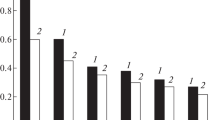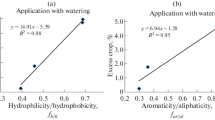The antioxidant properties of humic substances of low-mineralization sulfidic muds (peloids) were investigated using initiated oxidation of 1,4-dioxane as a model reaction. Four groups of substances including humic, himatomelanic, fulvic, and humus acids were studied. Kinetic characteristics of the oxidation of humic substances were determined in terms of effective inhibition rate constants fk In . It is established that himatomelanic acids of peloids exhibit the maximum antioxidant activity among the studied substances.
Similar content being viewed by others
Avoid common mistakes on your manuscript.
Excessive buildup of active oxygen species caused by disruption of pro- and antioxidant systems in vivo is a causative factor of many diseases such as atherosclerosis, diabetes, etc. Natural antioxidants (AO) in addition to synthetic drugs have recently attracted more and more attention as less toxic compounds. In this respect, humic substances found in medicinal muds are interesting. Biologically active peloid drugs with a broad spectrum of activity are currently developed based on them. The possibility of introducing them into health practice and rehabilitation procedures is being studied. The chemical composition of humic substances includes complicated mixtures of high-molecular-weight organic polyaromatic compounds formed by decomposition of plant and animal remains through the action of microorganisms and abiotic environmental factors. Humic substances are usually separated into fulvic acids (FA), himatomelanic acids (HMA), humic acids (HA), and humus acids (HsA).
The goal of the present work was to study the antioxidant properties of humic substances and their separate fractions isolated from low-mineralization sulfidic muds.
Experimental part
The antioxidant activity (AOA) of the humic substance fractions was studied using radical-chain initiated oxidation of 1,4-dioxane (I) under standard conditions at 348 K and initiation rate V i = 1 × 10–7 mol/L∙s in the kinetic oxidation regime as a model reaction [1]. The initiator of the oxidative processes was azodiisobutyronitrile (AIBN). 1,4-Dioxane was purified beforehand by the literature method [2]. AIBN was recrystallized twice from freshly distilled EtOH and dried in vacuo. Extracts of the substances were used without further purification. Ionol (2,6-di-tert-butyl-4-methylphenol, II) was purified by recrystallization from EtOH. The resulting crystals were dried and sublimed in vacuo.
Kinetic experiments were performed in a glass reactor into which a solution of the initiator in I was loaded and thermostatted for 10 min. Oxygen absorption was followed using a universal differential manometer, the construction of which was described in detail [3]. The oxidation rate V 0 was determined from the slope of the kinetic curve of oxygen absorption. The oxidation of I was inhibited in the presence of II and fractions of peloid humic substances. In this instance, V in 0 was determined from the initial portion of the kinetic curve. The initiation rate was calculated using the equation V i = k i ∙[AIBN], where k i is the initiation rate constant (s–1). It was assumed in calculating the initiation rate that k i = 2ek d , where k d is the AIBN decomposition rate constant and e, the probability of radical transfer into the bulk. Thus, the value measured in cyclohexanol was taken as k d [4], log k d = 17.70 – 35/θ (θ = 4.575 × T × 10–3, e = 0.5).
AOA was estimated from the degree of reduction of the initial rate of oxygen absorption during oxidation of the model substrate in the presence of added substances. The degree of inhibition of the oxidation and the effective rate constant of oxidation chain breaking fk In , where f is the AO radical capacity indicating the number of hydroxyperoxyl radicals consumed per AO molecule in chain-breaking steps, were used as objective quantitative characteristics of the AOA of the extracts [1].
Results and discussion
Extracted humic substances exhibited pronounced AOA according to the experimental results shown in Fig. 1. It was found that adding the studied compounds to oxidizing I caused a reduction of the oxygen absorption rate. The HMA showed the most pronounced AOA.
Initial oxidation rate of I as a function of humic substances concentration in coordinates of Eq. (1), V i = 1∙10–7 mol/L∙s, 348 K. Here and in Fig. 2, FA (1), HMA (2), HA (3), and HsA (4).
Figure 1 shows that the inhibition of the oxidation rate as a function of concentration approaches a limit. The oxidation rate at concentrations above 6 × 10–4 mol/L is independent of the amount of added peloid substance. This experimental fact indicates that the chain-breaking mechanism changed. Namely, the mechanism of quenching of hydroxyperoxyl radicals of I per inhibitor molecule at this concentration of the studied substances is linear.
The oxidation rate is given in mol/L because inhibition parameter F is a relative quantity. The initiated oxidation for all samples remained chain-like over the whole studied concentration range. This fact enabled Eq. (1) to be used to determine fk In [1]:
where V 00 and V 0 are the initial rate of oxygen absorption for oxidation of I in the absence and presence of inhibitor, respectively; [AO], the concentration of added AO; k In and 2 k 6, rate constants of oxidation chain breaking per AO and quadratic chain breaking per substrate peroxyl radicals, respectively [1]; 2 k 6 = 6.67 × 107 L/mol∙s [3].
It was found that Eq. (1) was obeyed satisfactorily for all studied substances (correlation coefficient > 0.95).
The quantity \( {{{f{k_{In}}}} \left/ {{\sqrt {{2{k_6} \cdot {V_i}}} }} \right.} \) was determined from the slope of these functions for each sample (Fig. 2).
The linear dependence of the inhibition parameter and the concentration of the studied acids in the range (0.25 – 18) × 10–4 mol/L indicated that quadratic chain breaking of initiated oxidation of I dominated in this concentration range.
The degree of oxidation inhibition by HA additives was estimated based on the experimental results. Also, effective inhibition rate constants fk In were found. The inhibition constant for HA was 3.0; HMA, 23; FA, 2.6; and HsA, 1.3 × 10–4 L/mol∙s.
The ionol equivalent (IE) was calculated using the formula IE = fk In /fk ionol . The quantity fk In for II that was found in separate experiments was (1.00 ± 0.15) × 10–4 L/mol∙s. Table 1 presents the results of the calculations.
The results of our research led to the conclusion that the HsA, FA, and HA fractions had AOA that was an order of magnitude less than the classical inhibitor (II). The HMA extract was about eight times better than HA with respect to the degree of inhibition of the oxidation process. HA was 1.2 and 2.3 times better than FA and HsA, respectively.
Thus, we determined the kinetic characteristics of oxidation of peloid humic substances. It was shown that extracted compositions of humic substances exhibit pronounced AOA according to the effective inhibition rate constants. The AOA varied in the order HMA–HA–FA–HsA.
References
E. T. Denisov and V. V. Azatyan, Inhibition of Chain Reactions [in Russian], IFKhCh RAS, Chernogolovka (1997).
A. J. Gordon and R. A. Ford, A Chemist’s Companion, Wiley-Interscience, New York (1972).
N. M. Emmanuel and D. R. Gal, Oxidation of Ethylbenzene [in Russian], Nauka, Moscow (1984), pp. 186–218.
E. T. Denisov, Rate Constants of Homolytic Liquid-Phase Reactions [in Russian], Nauka, Moscow (1971).
E. T. Denisov and I. B. Afanas?ev, Oxidation and Antioxidants in Organic Chemistry and Biology, Taylor and Francis, Boca Raton (2005).
Author information
Authors and Affiliations
Additional information
Translated from Khimiko-Farmatsevticheskii Zhurnal, Vol. 45, No. 3, pp. 50 – 51, March, 2011.
Rights and permissions
About this article
Cite this article
Avvakumova, N.P., Gerchikov, A.Y., Khairullina, V.R. et al. Antioxidant properties of humic substances isolated from peloids. Pharm Chem J 45, 192–193 (2011). https://doi.org/10.1007/s11094-011-0590-2
Received:
Published:
Issue Date:
DOI: https://doi.org/10.1007/s11094-011-0590-2






